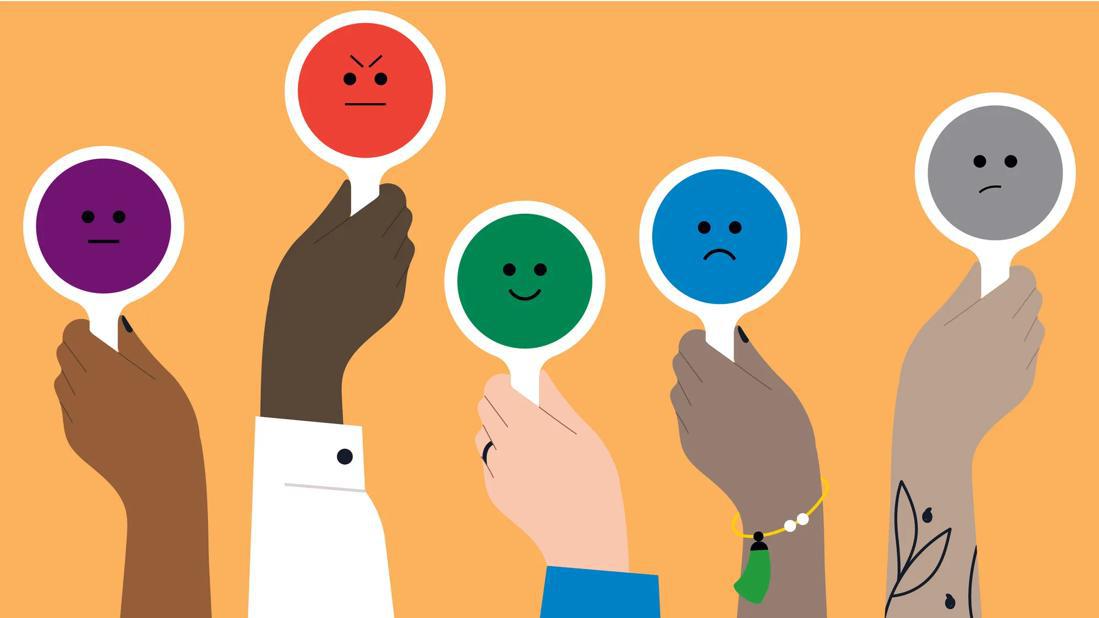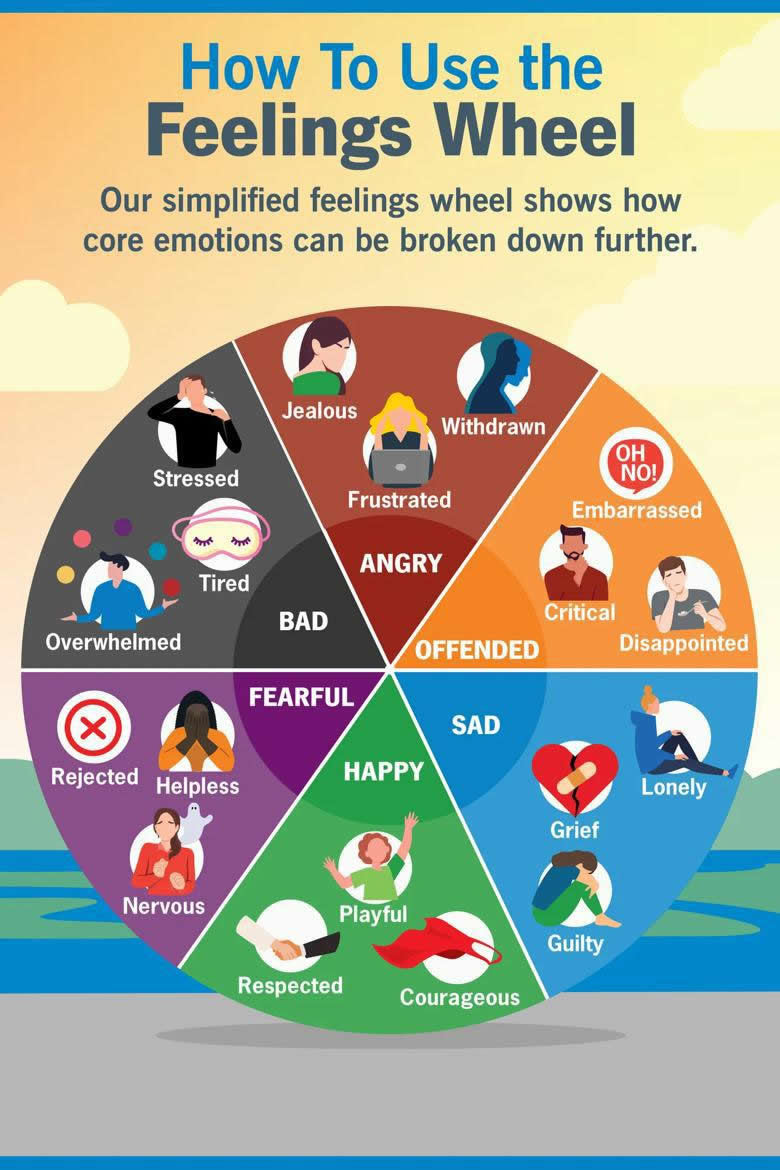How To Use a Feelings Wheel
Start from the center ring and work your way out to more defined, specific emotions

How are you feeling today? Are you sad or angry? Or are you really feeling disheartened or annoyed? These emotions may overlap one another, but when you can pinpoint exactly how you feel, you can better process your emotions and respond in a genuine, authentic way.
That’s where the feelings wheel may help.
Psychologist Kendra Mathys, PsyD, shares the science behind using a feelings wheel and why it’s helpful when you’re left feeling unsure or overwhelmed with emotion.
What is the feelings wheel?
The original “Feelings Wheel” was designed to help people identify, express and process difficult emotions. It was created by psychologist Gloria Willcox in 1982. It can be used by any individual to build emotional intelligence, enhance emotional awareness and care for their mental health.
It’s also often used in marriage or couples counseling as a tool to help partners openly express and communicate how they’re feeling with one another.
How does the feelings wheel work?
The feelings wheel is made up of three concentric circles that become more specific the farther you move away from the center.
In the smallest circle at the center, there are the most basic, broad emotions like “happy” or “sad.” We often tend to lean on these broader categories to describe our everyday emotional experience.
But if we dig deeper and investigate larger feelings, we can move out to the second circle. There, we could land on more defined emotions like “playful” or “lonely.”
The largest, outer circle then takes those emotions and boils them down even further to feelings like “inadequate” or “amused.”
Examples
“Sometimes it can be hard to name our emotions and it’s not uncommon for someone to group unpleasant or negative emotions into one general category,” says Dr. Mathys.
Anger might be the first emotion you identify, but within that, you could be feeling let down or even betrayed. You might also feel sad, hurt or disappointed. Nailing down your specific feelings and understanding the difference between these emotions can help you decide how to react, respond and cope with what’s happening.
“It’s way more vulnerable to feel disappointed or betrayed and to communicate that than it is to experience, express and communicate anger,” she continues. “If we stop at anger, it puts a limit on how we’re able to effectively cope with our emotions and receive support from others.”
Here are some other examples of how big, broad emotions can be broken down further when you use a feelings wheel:
- Feelings of fear might be understood as rejection or embarrassment.
- Feeling sad could be defined further as feeling ashamed or inferior.
- Feeling powerful could be better described as feeling important, intelligent or confident.
“Emotions aren’t mutually exclusive,” explains Dr. Mathys. “We can have a wide range of different emotions at once. This tool is really helpful in identifying the combination of emotions that might come up in the moment.”
For instance, you might feel rejected or guilty after a breakup. But you could also be fearful for your future, nervous or panicked.
How to use the feelings wheel

A feelings wheel can be helpful if you’re having a hard time identifying how you feel. It can also be used as a way to check in with yourself throughout the day as a form of self-care and self-awareness.
Here’s how to make the most out of it:
- Keep the feelings wheel in a visible location where it’s easily accessible.
- Start with the innermost circle to identify broad, core emotions that resonate with you.
- Move out to the middle and outer rings to find more specific, detailed emotions that better define how you’re feeling.
- Alternatively, you can scan the entire wheel and pick out any feelings that resonate with you in the moment.
- Pay attention to physical sensations in your body that accompany the identified emotion. Are you clenching your jaw? Do you feel nauseated? Are you trembling?
- Once you’ve identified your emotions and acknowledged how they’re physically affecting you, consider journaling about them, talking to someone or bringing these experiences to a therapist.
“Just naming your emotions takes some of the power away from them and makes them a little bit more manageable,” says Dr. Mathys. “If you’re noticing a pattern of difficult emotions that keeps coming up and it’s really hard for you to cope with it, that’s a sign that therapy might be really helpful.”
Other feelings wheels and emotion wheels
A quick online search will result in a bunch of different options for feelings wheels. Each comes with its own set of terms and color-coded formats that help people clue in to what they’re feeling.
In truth, any of these feelings wheels can be useful if they make it easier for you to reflect on your own experiences. But the Plutchik Wheel (also known as the emotions wheel) from psychologist Robert Plutchik is one of the most common alternatives to Willcox’s version.
Plutchik’s wheel of emotions identifies eight core emotions broken up into opposite pairings:
- Joy and sadness
- Trust and disgust
- Fear and anger
- Surprise and anticipation
These primary emotions are located inside the second of three circles. These emotions get more intense as you move toward the center of the smallest circle, and they become less intense when you move to the outer edges. In between each spoke, there are other mixed emotions: love comes from joy and trust; remorse comes from sadness and disgust.
“Plutchik’s emotions wheel is aimed at helping people understand the relationship between emotions and how they can change in intensity,” explains Dr. Mathys. “By acknowledging the intensity of your emotions, it offers you different perspectives on what you need and how you can respond to them.”
For example, breathing exercises or meditation might be helpful when your anxiety is at a four or a five. But if your anxiety rises to a nine or 10 — to the point of panic — you might need a shock of cold water or fresh air to help lower that intensity. Or you might need to ask for help from a trusted friend, family member or therapist.
“Emotions can be difficult for a lot of people, but we can manage them better if we know where to look,” encourages Dr. Mathys. “These tools are designed to help you through that process.”